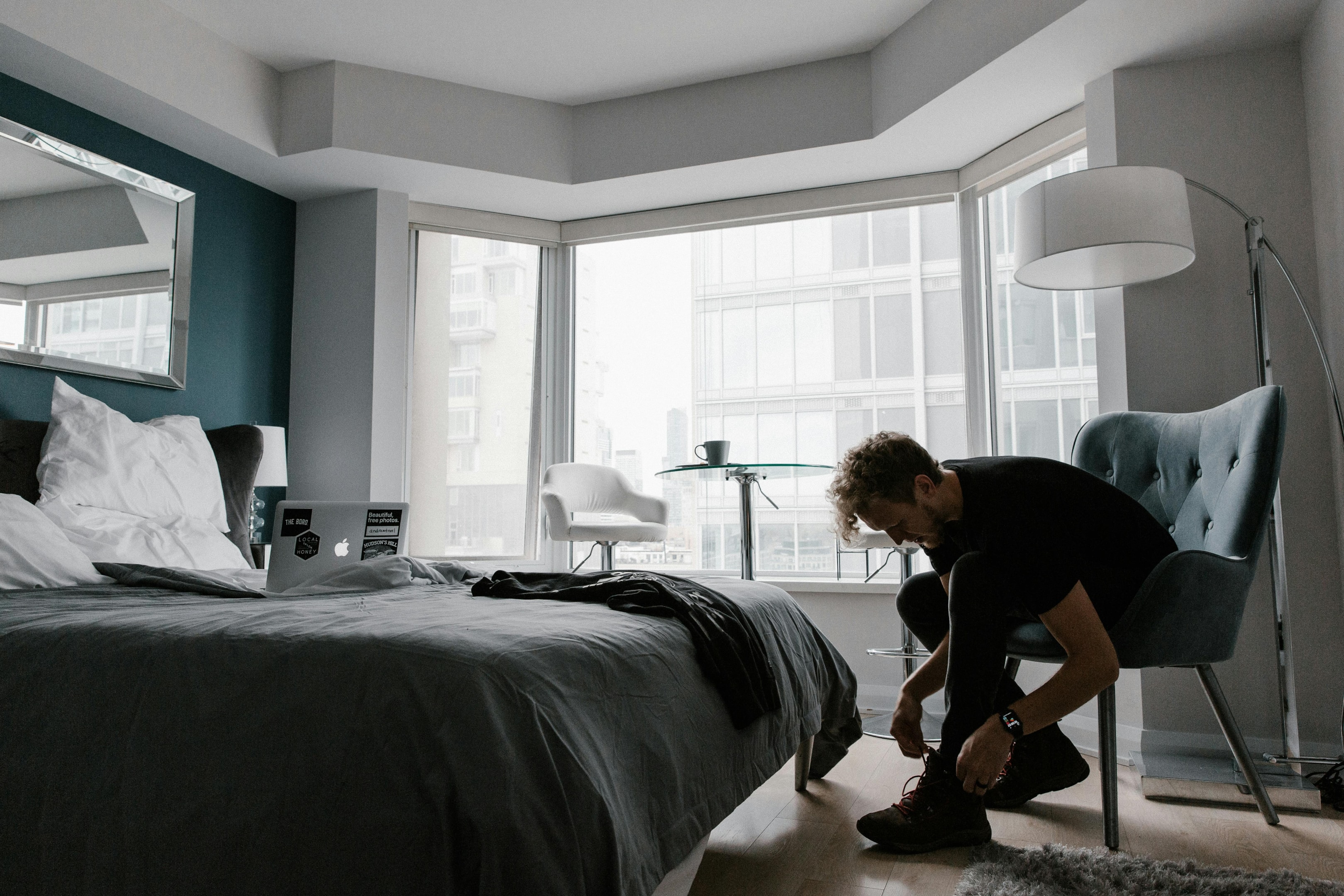What you do with your day is what you do with your life, and our day is comprised of habits. Whether or not we created them intentionally, most of our daily actions are the result of some habit we formed in the past.
If we want to change our lives, we change our habits. Here’s how.

What is habit stacking?
Habit stacking is a technique to help new habits stick. The process of “stacking” is attaching a new desired habit onto an already well-established part of your routine.
The idea is to leverage your consistency of the existing habits to make it easier to adopt new ones.
“I don’t have any good habits,” you might be thinking. First of all, I doubt that’s true, but secondly, they can be neutral habits! You probably get out of bed in the morning, no? That’s a habit.
Here’s how it works:
1. Identify existing habits. Those things you do every day.
2. Pair with new habits. Strategically couple your desired habit with a logical established one.
3. Create stacks. Add onto your stacks progressively, a little at a time.
4. Reinforce your routine. Help yourself out by planning, preparing, and sticking to your routine. You might include reminders or rewards.
Habit stacking is effective because it reduces the cognitive load of trying to remember and implement new behaviors. It’s like a cheat code. And that’s it. Habit stacking is simple, but hugely effective. Read on for the science of why it works, tips for doing it effectively, examples, and a habit stacking template.

Does habit stacking work?
Yes, habit stacking works! Let me give you a flyover of what’s happening in your brain when you habit stack.
Your brain is full of neurons, which are cells that transmit information through electric and chemical signals. They are the basic building block of your nervous system.
Neurons are connected to one another through synapses. Synapses allow neurons to transmit those signals to each other (or to other cells).

When our brain repeatedly accesses certain memories or skills, that synapse grows stronger and gains elasticity. If we don’t access that memory or skill for a while, the synapse can weaken and deteriorate. Use it or lose it.
So when we’re looking to form new habits, habit stacking works by connecting that new memory to an established one that already has a strong synapse. This makes forming the new habit easier, because the entryway is paved.
For example, you probably get up and use the restroom first thing in the morning without thinking about it. That’s a strong neural pathway. If you add a bathroom chore to that, like cleansing your face, it will lock in faster than if you did it alone, because of the strength and elasticity of that synapse that brings you from your bed to the bathroom.
(I am not encouraging illegal drug use.) Psychedelics, such as psilocybin, can increase the elasticity of your synapses, creating, strengthening, or reconnecting them. Early research shows this as an effective treatment for many mental disorders, like PTSD, through reconsolidating those traumatic memories with the enhanced elasticity.
It’s all pretty cool, but yeah, habit stacking works.

Habit Stack with Triggers
Triggers, or cues, for habits happen through your entire day, whether you realize it or not.
- The dog barks, you open the door.
- You wake up, you go to the bathroom.
- It starts raining, you put your houseplants outside.
- Your stomach growls, you get a snack.
- Work ends, you go home.
A cue might be a time of day, a physical sensation, or an event. Some desirable habits you want to add might have a natural cue built-in.
- The mail arrives, and you deal with it immediately instead of stacking it by the door.
- You go to a party and introduce yourself to three new people.
- You leave the house and remember to set up a puzzle for the cat before you go.
If those natural cues don’t work, you can help yourself along. Put a plant or a picture frame where you normally drop the mail. Tell a friend your intentions to meet new people. Put the cat puzzle by the door.
To coordinate and strategize your possible habit triggers, make a list of things that you do every day, or things that happen every day. Like this:
- The sun rises
- Get out of bed
- Get ready for the day
- Walk the dog
- Water the trees
- Open the curtains
- Eat breakfast
- Straighten up the house
- Catch up with phone notifications
- Review to-do list
- Start work
- Exercise
- Eat lunch
- The mail carrier comes by
- The dog needs to go out
- The rats wake up
- Eat a snack
- Journal in the garden
- Talk/hang out with a friend
- Walk the dog x2
- The sun sets
- Close the curtains
- Clean up
- Journal
- Read
- Go to bed
Those are my possible triggers. Let’s say I want to add the following habits to my day:
- Call potential client
- Fill the humidifier
- Teach my rats a new trick
- Meditate
I can add calling a potential client to before I catch up on my phone notifications, or after lunch.
I can add filling the humidifier after watering the trees, because I already have the garden hose out, and I can use that since the humidifier is by the front door.
If I want to teach my rats a new trick, I’d do it after they wake up.
Meditating would fit in well with either of my journaling sessions, since I’m already being still in a quiet place.
Take some time to strategize your habit pairings–not all combinations will work!
Here’s how to do it.

1. Start small
Rome wasn’t built in a day, etc., so start with one easy habit. Once you have it cemented in your routine, you can stack on top of it.
2. Find the right trigger
You might run through a few different triggers before you find the one that works for that habit.
Consider the ease of transition from the established habit to the desired habit–going for a run after lunch might not work as well as going for a run after work.
Consider when and where those tasks happen. If you’re adding a task that happens in the kitchen at 9am, tie it to a habit that already happens in the kitchen around 9am.
3. Be specific
Vagueness is a goal-setter’s enemy. Be concrete and specific with your habit. Name the trigger, decide if the new habit goes before or after that trigger, and give yourself a precise habit to practice.
Not specific: I’ll add meditation into my morning routine.
Specific: After I get out of the shower, I’ll meditate for five minutes. I can leave my meditation pillow on the living floor to remind me.
Not specific: I want to stop scrolling at night.
Specific: I’ll put my phone charging in my office after I eat dinner, and I won’t use it until tomorrow.
4. Build sequences
Start with one small habit, as we’ve said, but once you’ve nailed that one, you can build habit sequences. The end of one habit will trigger the beginning of another in a chain. Here’s what a morning stack might look like:

5. Prepare
In the above image, you’ll notice a few of the habits are prepared for. This can be leaving notes for yourself, laying out the materials you’ll need (clothes, journal and pen), and minimizing any barriers between you and that habit. The more accessible you make the habit, the easier it is to implement.
Habit Stacking Examples
Morning routine:
1. After waking up (nonnegotiable), make your bed. 2. After making your bed, tidy up your room for a minute or two.
Work break:
1. When you finish a work task (a thing you’ll do anyway), take a quick walk around your house or office for an active break. 2. You can think on what you’ll do next while you walk.
Dinner:
1. After dinner (girl’s gotta eat), put away leftovers and clean the kitchen. 2. After you’ve cleaned the kitchen, wrap up any text conversations and store your phone for the night.
Bedtime:
1. After you shower/change into pajamas (existing habit), read for 20 minutes. 2. After you read, do a mindfulness exercise.
Best Habit Tracker
The best habit tracker is the one that you enjoy using. Be that a habit scorecard, a graph in your bullet journal, an online tracker, or a calendar you keep at your work station.
Here are a few more ways you can track your new healthy habits.
- For daily habits, it might make sense to keep something small–like a notecard–around the area that the habit happens. For example, you could tape one to your bathroom mirror to track when you’ve done your skin routine.
- Habitica is gamified to-do list that gives in-game rewards for completing daily habits.
- Bullet journals are great for artsy people who Have The Time.
- Jerry Seinfeld’s system where he makes an X on a calendar each time he performs a new habit and tries not to break the chain.
- The printable weekly habit tracker you can download for free at the bottom of this article.
The best habit tracker is whichever one you will use consistently, and you may need to experiment with a few before finding the best for you.
Habit Stacking Template / Habit Stacking Formula
To sum up the important bits, here’s a habit stacking template you can use to start your stack.
EXISTING HABIT:
Identify your established habits and events (like the list we made earlier)
NEW HABIT:
Specify the new habit you want to adopt
DETAILS:
Decide when, where, and under what circumstances you will perform the new habit
TRIGGER STATEMENT:
Create a trigger statement with this format: Before/After [existing habit], I will [new habit].
ASSIST:
How will you prepare and motivate yourself to stick to your routine?

Free Weekly Habit Tracker
Download this habit tracker to keep yourself motivated and organized this week.
Just start small and take it one day at a time. Repetition is everything, so repeat until it becomes second nature. If you’re struggling after trying for a few weeks, you may need to attach your new habit to a different trigger. Good luck!
3 Comments